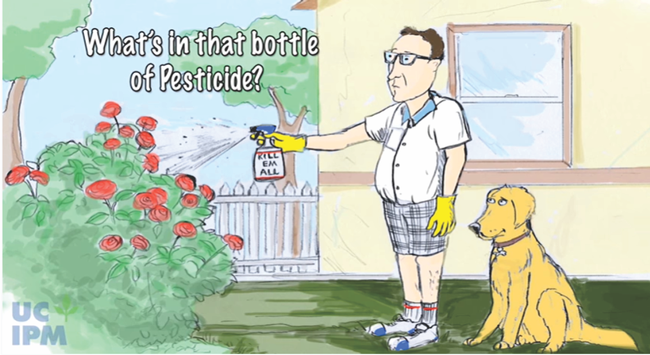Use compost, not chemicals
This is the second post in this series following concepts and information from UC Master Gardeners of Napa County presentation, “Soil is the Solution, healing the earth one yard at a time,” https://www.youtube.com/watch?v=JqA8DqBtRuo . The presentation describes practices we can learn and implement about soil to help slow and ultimately reverse the damage humankind has done. The first post was May 24, 2021.

Using a military analogy, a reconnaissance mission is our first task. Once a pest has been properly identified, determine the number of pests and the extent of damage they are causing. Next, deploy a combination of biological, cultural, mechanical, and chemical management tools into combat. IPM almost always uses a combination of management techniques instead of dependence on only one method. While one of the goals of IPM is to reduce chemical applications, there are times where the best strategy involves the use of pesticides, but careful timing and the amount applied is critical to reduce the impact to non-target species and environmental degradation. For more complete descriptions of IPM's management tools see http://www.ipm.ucdavis.edu/
The use of chemical fertilizer gets us nothing as we endeavor to improve our soil. We might get plants that we can liken to a weightlifter pumped up on steroids, but take that away and we have some mediocre to sickly looking plants. Plants grown in healthy soil sustain themselves. It can be argued that on a molecular level, the primary nutrients of nitrogen (N), Phosphorus (P) and Potassium (K) are the same in both chemical fertilizer and in natural fertilizer. True, but if we leave out the fundamental operation that healthy soil provides to plants, (remember we get healthy soil by applying compost, whose organic elements nurture microorganisms,) we short circuit the natural process that mother nature has used for millennia. Instead of feeding plants, we need to feed the soil. From there, what nature intended will take over and the soil will feed the plants.
In the presentation, a convincing example illustrated how composted soil is the best nourishment plants can have. The experiment showed the biomass of root systems of borage plants grown using different methods of fertilization. The first example was the control, plants grown not using any product, had a root system that looked pretty good. Example two used synthetic fertilizer and there was almost no root system at all. The third example used an organic product; its roots looked about the same as using nothing at all. The fourth example was grown in composted soil. This plant's root system was the lucky winner. The roots formed an impressively large, healthy looking mass. That's what nature intended.
Master Gardeners are following recommended social distancing guidelines that keep everyone safe, Napa Master Gardeners are available to answer garden questions by email: mastergardeners@countyofnapa.org. or phone at 707-253-4143. Volunteers will get back to you after they research answers to your questions.
Visit our website: napamg.ucanr.edu to find answers to all of your horticultural questions.
Resources:
Photo credits: UC IPM video https://www.youtube.com/watch?v=UJeEVQm-9uE